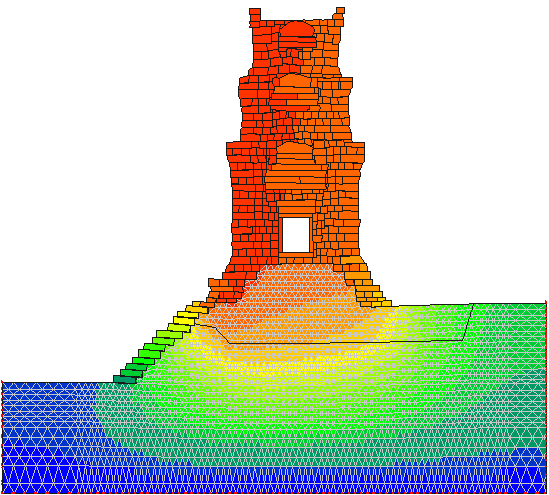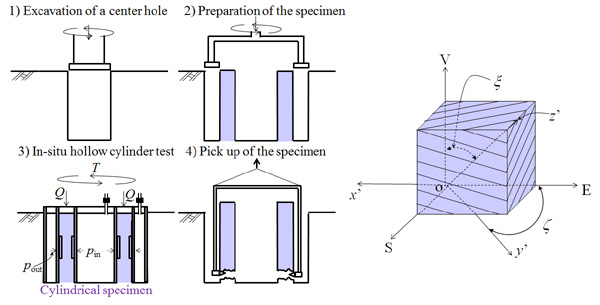RESEARCH
Research on seismic performance of defective tunnels

It has been reported that tunnels constructed using the sheet pile method at the period of high economic growth have insufficient lining thickness, back cavities, and loose areas at the top due to the concrete placing technology and the methods adopted in construction management. Furthermore, in tunnels that have been in service for several decades, it is often reported that the strength of the surrounding ground has decreased and caused heaving related problems. These tunnels are not always safe in the event of an earthquake since the mechanical characteristics and load conditions of the ground change significantly from those at the time of design. Therefore, in this study, the behavior of the deteriorated loose area or a cavity behind tunnel during an earthquake will be examined
Maintenance and improvement of geotechnical structures in transportation

Roads, railroads, and airports support the movement of people, goods, and
information, and occupy a major role in the development of cities. It is
said that a country will decline if such infrastructure cannot be maintained
properly. Automobiles, trains, aircraft, etc. will run on a daily basis
after the construction of roads, railroads, airport facilities, etc. Repeated
traffic loads and further exposure to environmental conditions such as
rain, snow, and sunlight can lead to deterioration of materials, and thereby
the structures in those facilities. Roads may suddenly collapse, or railroad
rails may suddenly distort in midsummer, making the facility inoperable.
Therefore, in order to minimize such "risks", we conduct research
on maintenance and improvement of structures used in transportation facilities
to tackle the geotechnical engineering issues.
Study on changes in water retention behaviour of sandy soil due to internal erosion

It has been pointed out that internal erosion causes an increase in soil
void volume, and changes in particle size, which results in the destabilization
of the soil and reduces the stability of river embankments. On the other
hand, the stability of the embankment during heavy rain is considered to
be greatly affected not only by the strength, but also by the ease of water
penetration, that is, the water retention ability of the embankment. But
this is not enough to consider changes in the water retention ability caused
due to internal erosion. Therefore, in this study, we try to model the
water retention behaviour by using the particle size distribution and the
pore ratio as indicators, with the aim of clarifying the change in the
water retention of the ground caused due to internal erosion.
Carbon recycling of geomaterials

In 2009 G8 L’Aquila Summit, it was reaffirmed to half the global GHG (greenhouse
gas) emissions by 2050, and as a part of this, it was announced to support
the goal of reducing global GHG emissions by more than 80% across the developed
countries. Under these circumstances, it is necessary to pursue all technical
options in order to significantly reduce CO2 emissions associated with
the use of fossil fuels by 2050. From this point of view, the Ministry
of Economy, Trade and Industry regards CO2 as a carbon resource, recovers
it, and promotes carbon recycling to reuse it in other forms. In this regard,
through geotechnical engineering, we conduct research on carbon recycling
of geomaterials to absorb CO2 during their manufacturing processes.
Method of deformation analysis for composite structures of soils and masonry stones

The coupled numerical manifold method (NMM) and discontinuous deformation analysis (DDA) areenhanced to simulate deformations of continuous soil and discontinuous masonry structures. Anelasto-plastic NMM-DDA is formulated that incorporates elasto-plastic constitutive laws into incremen-tal forms of the equation of motion. A node-based uniform strain element is applied to avoid volumetriclocking, which often occurs in conventional NMM-DDA. The proposed method is applied to three funda-mental boundary value problems: a beam bending problem, a bearing capacity problem of a footing, anda bearing capacity problem of a masonry structure. The method is verified through comparisons with conventional solutions
An Experimental Method to Determine the Elastic Properties of Transversely Isotropic Rocks by a Single Triaxial Test

A novel method is proposed for determining the deformation anisotropy of rocks by a single triaxial test using a single specimen sampled from an arbitrary direction. Transversely isotropic elasticity is assumed for the purpose of application of the test method to sedimentary and metamorphic rocks, and the non-axial symmetric stress–strain relationships of anisotropic rocks are determined by triaxial testing by means of a simple improvement to the cap in the triaxial testing apparatus. Both the elastic parameters and the directions of the transversely isotropic elasticity can be obtained by measuring the shear deformations that occur under triaxial stress conditions. An overview of the method for determining transversely isotropic elasticity is presented in this paper, along with the results of a sensitivity analysis performed assuming simulated strains with random measurement errors. The results show that the directions of anisotropy can be determined precisely using the directions of the principal strains measured during isotropic compression and that the elastic parameters can be determined uniquely from the stress–strain relationships observed during both the isotropic and axial compression processes.